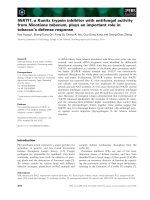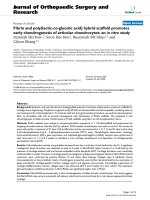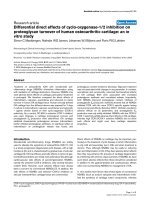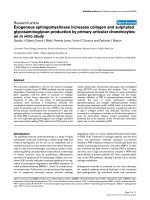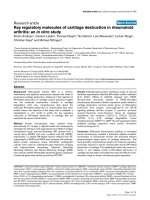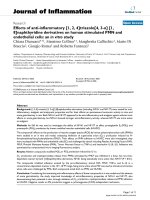Antifungal activity of biogenic platinum nanoparticles: An in vitro study
Bạn đang xem bản rút gọn của tài liệu. Xem và tải ngay bản đầy đủ của tài liệu tại đây (165.19 KB, 7 trang )
Int.J.Curr.Microbiol.App.Sci (2017) 6(4): 334-340
International Journal of Current Microbiology and Applied Sciences
ISSN: 2319-7706 Volume 6 Number 4 (2017) pp. 334-340
Journal homepage:
Original Research Article
/>
Antifungal Activity of Biogenic Platinum Nanoparticles: An in vitro Study
Kapil Dev Sharma*
Research Scholar, Shri JJT University, Jhunjhunu, Rajasthan 333001, India
*Corresponding author
ABSTRACT
Keywords
Biogenic, Platinum
nanoparticles,
Antifungal.
Article Info
Accepted:
02 March 2017
Available Online:
10 April 2017
The aim of this study was to screen biogenic platinum nanoparticles for antifungal
properties by a combination of in vitro methods. During this study, marine actinobacteria
(Streptomyces sp. mediated biogenic platinum nanoparticles were screened for their
antifungal activity against Aspergillus flavus, A. niger, Penicillium sp., Candida albicans
and C. tropicalis. Biologically synthesized platinum nanoparticles exhibited broad
spectrum antifungal activity against test organisms. Particles exhibited high activity
against yeast viz, Candida albicans (16.66±1.52) and C. tropicalis (18.33±1.52), while
moderate antifungal activity against molde viz, A. flavus (11.00±1.00), A. niger
(09.33±1.52), Penicillium sp. (06.00±1.00). These particles exhibited antifungal activity
with minimum inhibitory concentration ranging from 10-40μg/ml.
Introduction
potential
(Vanden
et
al.,
1997).
Nanotechnology is a science that deals with
the synthesis, development, manipulation and
applications of tinny molecules that measure
100 nanometers or less. Due to their very
small size, they carry unique properties and
can be utilize for the development of new
products. Most recently, there is a global
interest among the scientists to develop,
improve, employ and use nanoparticles for
solving various problems encountered by
mankind. In recent past, a variety of metallic
and
non-metallic
nanoparticles
are
extensively used in various fields such as
pharmaceuticals, optical devices, catalyst,
bioremediation, electronic and sensor
technology (Praetorius et al., 2007; Karthik et
al., 2013; Anderson et al., 2006; Jiang et al.,
2005; Agarwal et al., 2014; Sharpe et al.,
2014).
Fungi are very important group of
microorganisms with maximum number of
representatives. Fungi provide several direct
or indirect benefits to mankind such as
decomposition
of
organic
material,
bioremediations of toxic materials, production
of antibiotics and other industrial products etc
(Rani et al., 2014; Kawaguchi et al., 2013;
Sunna et al., 1997). In contrast to the benefits,
fungi can also leads a variety of diseases in
plants, humans and animals. Fungal infection
such as, Aspergillosis, Candidiasis and
Mucormycosis etc. pose a significant negative
impact on human health, most of the fungi
produces slow and long term infection in
human body and is quite difficult to eliminate.
Development of drug resistance in pathogenic
strains is an important virulence factor of
fungi, therefore there is a constant need to
develop newer products with antifungal
334
Int.J.Curr.Microbiol.App.Sci (2017) 6(4): 334-340
Various nanoparticles viz. silver, gold, zinc
oxide, platinum are being excessively used in
several
industries
such
as
food,
pharmaceutical and bioelectronics. Among
them platinum nanoparticle is one of the rare
and very useful variety of nanoparticle. In
recent past, platinum nanoparticles have been
reported to exhibit great antioxidant
properties. Platinum nanoparticles are also
being used for coating materials, and for the
development of nanofibers and polymer
membranes.
biogenic platinum nanoparticles. All fungal
cultures were maintained on potato dextrose
agar medium and stored at 4°C.
Antibiogram
These particles are also reported to have great
applications in the development of fuel cells
and hydrogen storage materials (Wen et al.,
2008; Li et al., 2007). In recent past
nanoparticles have been reported to exhibit
significant antimicrobial activity (Ahmed et
al., 2016; Elhusseiny et al., 2013), however
the reports on antifungal activity remains
limited. Therefore, this study is designed to
screen the platinum nanoparticles for their
properties to inhibit the growth of fungi.
All the clinical isolates of fungi were screened
for their sensitivity towards standard
antibiotics by disc diffusion method.
Antibiotics included Miconazole (10 μg/disc),
Clotrimazole (10 μg/disc), Ketoconazole (10
μg/disc), Amphotericin -B (20 µg/disc) and
Fluconazole disc (10μg/disc). Drug sensitivity
test was performed by disc diffusion method
on Potato dextrose agar plates. Fungal isolates
were inoculated in to potato dextrose broth for
8 hours. Isolates were seeded on potato
dextrose agar plates by using sterilize cotton
swabs. The standard antibiotic discs were
placed on the agar surface using a sterilize
forceps. Plates were incubated at 28°C for 4872 hours. Plates were observed for zone of
inhibition. The experiment was performed in
triplicates (Perez et al., 1990).
Materials and Methods
Antifungal activity
Platinum nanoparticles were previous
biologically synthesized using marine
actinobacteria Streptomyces sp. isolated from
soil sediments samples collected from coastal
areas of Chennai, India, while Chloroplatinic
acid hexahydrate was used as substrate. These
nanoparticles were characterize using, UVvisible spectrophotometer, FTIR Spectroscopy, XRD and TEM analysis (Data not
shown).
Antifungal activity of the biologically
synthesized platinum nanoparticles was
checked by agar well diffusion method on
Potato dextrose agar plates. The fungal
cultures were lawn cultured on potato
dextrose agar plates by using sterilised cotton
swabs. In each of these plates, three wells
were cut out using a standard cork borer (7
mm diameter). Using a micropipette, 100 µl
of Chloroplatinic acid hexahydrate solution
(100µg/ml), 100µl of platinum nanoparticle
(100µg/ml) and 100µl of distilled water was
added to separate wells. Plates were incubated
for 48-72 hours at 28°C. Anti-fungal activity
was evaluated by measuring the zone of
inhibition (Kumar et al., 2010). Experiment
was performed in triplicates.
Antifungal activity
nanoparticles
of
the
platinum
Test organisms
Aspergillus flavus, A. niger, Penicillium sp.,
Candida albicans and C. tropicalis were used
for studying the antifungal activity of
335
Int.J.Curr.Microbiol.App.Sci (2017) 6(4): 334-340
Determination
inhibition
of
relative
nanoparticles are expressed as mean ±
standard deviation of the response of 3
replicates determinations per sample. Results
were analyzed by using Microsoft Excel
2007.
percentage
The relative percentage inhibition of the
biologically
synthesized
platinum
nanoparticles with respect to positive control
was calculated by using the following formula
(Kumar et al., 2010).
Results and Discussion
Platinum is a very rare and one of the most
costly metal available on earth. It’s highly
resistance to corrosion and is the least reactive
metal therefore used widely for specific
applications. Platinum is being widely used in
nanotechnology and can be reduced to
nanoparticles by various physical, chemical
and biological processes. These nanoparticles
can exhibit unique properties depending upon
the method used for the production of
particles and their size.
Relative percentage inhibition of the
biologically
synthesized
platinum
nanoparticles =
[100 × (x-y)] / (z-y)
Where,
x: total area of inhibition of the biologically
synthesized platinum nanoparticles
y: total area of inhibition of the solvent
z: total area of inhibition of the standard drug
The total area of the inhibition was calculated
by using area = πr2; where, r = radius of zone
of inhibition.
inhibitory
In recent past, platinum nanoparticles has
been
reported
to
exhibit
several
pharmaceutical properties such as antioxidant
activity, anticancer activity (Borse et al.,
2015) and antimicrobial activity (Rajathi et
al., 2014).
MIC of the biologically synthesized platinum
nanoparticles was performed by modified
agar well diffusion method. Sample was
diluted in sterilized distilled water to make a
concentration range from 1-1000μg/ml. Test
cultures were inoculated in PDB and seeded
on PDA plates using sterilized cotton swabs.
In each of these plates four wells were cut out
using a standard cork borer (7 mm). Using a
micropipette, 100 µl of each dilution was
added in to wells. Plates were incubated at
28°C for 72 the results were recorded. The
minimum concentration of each extract
showing a clear zone of inhibition was
considered to be MIC (Rios et al., 1988;
Okunji et al., 1990).
In
a
study,
pectin
and
sodium
borohydride synthesized
platinum
nanoparticles
exhibited
significant
antibacterial activity against Escherichia
coli and Aeromonas hydrophila. In another
study, phytofabricated platinum nanoparticles
exhibit strong antibacterial activity toward
Vibrio cholera, Staphylococcus aureus,
Streptococcus pyogens, Salmonella typhi and
E. coli. During this study the biologically
synthesized platinum nanoparticles were
screened for their antifungal activity by using
various in vitro methods.
Determination of minimum
concentration (MIC)
Antibiogram study
Antibiogram studies performed against fungal
isolates provide systemic information about
the drug resistant pattern of the test cultures
against commonly used antibiotics.
Statistical analysis
The results of the antifungal activity of
biologically
synthesized
platinum
336
Int.J.Curr.Microbiol.App.Sci (2017) 6(4): 334-340
Table.1 Antibiogram study of fungal isolates
Test organisms
A. flavus
A. niger
Penicillium sp.
C. albicans
C. tropicalis
Antibiotics used
Miz
Ctz
S
R
R
S
R
S
S
I
S
S
Kt
S
S
S
I
S
Ap
S
S
S
I
S
Fu
S
S
S
S
S
S: Sensitive, I: Intermediate, R: Resistant, n.a.: not applied,
Miz: Miconazole (10 μg/disc), Ctz: Clotrimazole (10 μg/disc), Ketoconazole (10 μg/disc), Ap:
Amphotericin-B (20 µg/disc), and Fu: Fluconazole disc (10μg/disc)
Table.2 Antifungal activity of biologically synthesize platinum nanoparticles
Test organism
Zone of inhibition (mm)
Pt NPs
PC
11.00±1.00 17.33±2.08
09.33±1.52 16.00±3.00
06.00±1.00 15.66±1.52
16.66±1.52 19.33±1.52
18.33±1.52 23.00±1.73
Aspergillus flavus
Aspergillus niger
Penicillium sp.
Candida albicans
Candida tropicalis
NC
0.0±0.0
0.0±0.0
0.0±0.0
0.0±0.0
0.0±0.0
Here, PC: positive control, NC: negative control
Values are expressed as mean ± standard deviation of the three replicates,
Zone of inhibition not include the diameter of the well.
Table.3 Relative percentage inhibitions of biologically synthesize platinum nanoparticles
Test organism
Aspergillus flavus
Aspergillus niger
Penicillium sp.
Candida albicans
Candida tropicalis
RPI (%)
40.27
34.02
14.66
74.31
63.53
RPI: Relative percentage inhibition
Table.4 Minimum inhibitory concentrations of biologically synthesize platinum nanoparticles
Test organism
Aspergillus flavus
Aspergillus niger
Penicillium sp.
Candida albicans
Candida tropicalis
MIC (µg/ml)
20
40
20
10
10
MIC: Minimum inhibitory concentration
During this study, Aspergillus flavus, A. niger,
Penicillium sp., Candida albicans and C.
tropicalis were subjected to antibiogram study
against antifungal drugs such as miconazole,
337
Int.J.Curr.Microbiol.App.Sci (2017) 6(4): 334-340
clotrimazole, ketoconazole, amphotericin-B
and fluconazole disc. Results represents that
almost all the fungal cultures were sensitive
towards the tested antibiotics, however A.
flavus
exhibited
resistance
towards
clotrimazole, while A. niger and Penicillium
sp. resist miconazole. Results of antibiogram
study are summarized in Table 1.
nanoparticles against fungal strains were
range between 10-40 µg/ml. The biologically
synthesize platinum nanoparticles exhibited
minimum inhibitory concentration against C.
albicans (10 µg/ml), C. tropicalis (10 µg/ml),
followed by A. flavus (20 µg/ml), Penicillium
sp. (20 µg/ml) and A. niger (40 µg/ml).
Results of MIC values of the biologically
synthesize platinum nanoparticles are
summarized in Table 4.
Antifungal
activity
of
biologically
synthesize platinum nanoparticles
During this work, actinobacteria mediated
biogenic platinum nanoparticles were
evaluated for its antifungal property. These
particles exhibited a significant antifungal
activity against a broad range of fungi
including C. albicans, followed by C.
tropicalis, A. flavus, A. niger and Penicillium
sp. It could be concluded that marine
actinobacteria can effectively produce
platinum nanoparticles with broad spectrum
antifungal properties.
In this study, biologically synthesize platinum
nanoparticles was screened for antifungal
activity against Aspergillus flavus, A. niger,
Penicillium sp., Candida albicans and C.
tropicalis. Biologically synthesized platinum
nanoparticles exhibited high antifungal
activity, while highest antibacterial activity
was shown against C. tropicalis (18.33±1.52),
followed by C. albicans (16.66±1.52), A.
flavus (11.00±1.00), A. niger (09.33±1.52)
and Penicillium sp. (06.00±1.00). Results of
antifungal activity of biologically synthesize
platinum nanoparticles are summarized in
Table 2.
Acknowledgement
Authors wish to thank management of Shri
JJT University, Jhunjhunu, Rajasthan, India,
for providing necessary facilities and support
for the completion of this work.
Relative percentage inhibition
During this study, antifungal activity of
biologically synthesize platinum nanoparticles
was compared with the antifungal activity of
standard drugs for evaluating relative
percentage inhibition. The biologically
synthesize platinum nanoparticles exhibited
maximum relative percentage inhibition
against C. albicans (74.31%), followed by C.
tropicalis (63.53%), A. flavus (40.27%), A.
niger (34.02%) and Penicillium sp. (14.66%).
Results of relative percentage inhibition are
summarized in Table 3.
References
Agarwal, A., Mehra, A., Karthik, L., Kumar,
G., Rao, K.V.B. 2014. Antibiofouling
property of marine actinobacteria and
its mediated nanoparticle. Int. J.
Nanoparticles, 7: 294-306.
Ahmed, K.B., Raman, T., Anbazhagan, V.
2016. Platinum nanoparticles inhibit
bacteria proliferation and rescue
zebrafish from bacterial infection. RSC
Adv., 6: 44415-44424.
Anderson, D.J., Moskovits, M. 2006. A
SERS-active system based on silver
nanoparticles tethered to a deposited
silver film. The J. Physical Chem. B.,
Minimum inhibitory concentration
Minimum inhibitory concentration values of
the
biologically
synthesize
platinum
338
Int.J.Curr.Microbiol.App.Sci (2017) 6(4): 334-340
110: 13722-13727.
Borse, V., Kaler, A., Banerjee, U.C. 2015.
Microbial synthesis of platinum
nanoparticles and evaluation of their
anticancer activity. Int. J. Emerging
Trends in Electrical and Electronics,
11: 26-31.
Elhusseiny, A.F., Hassan, H.H. 2013.
Antimicrobial and antitumor activity of
platinum and palladium complexes of
novel spherical aramides nanoparticles
containing
flexibilizing
linkages:
structure–property
relationship.
Spectrochimica Acta Part A: Mol.
Biomol. Spectroscopy, 103: 232-245.
Jiang, Z.J., Liu, C.Y., Sun, L.W. 2005.
Catalytic
properties
of
silver
nanoparticles supported on silica
spheres. The J. Physical Chem. B., 109:
1730-1735.
Karthik, L., Kumar, G., Keswani, T.,
Bhattacharyya, A., Palakshi Reddy, B.,
Rao,
K.V.B.
2013.
Marine
actinobacterial
mediated
gold
nanoparticles synthesis and their
antimalarial activity. Nanomed., 9: 95160.
Kawaguchi, M., Nonaka, K., Masuma, R.,
Tomoda, H. 2013. New method for
isolating antibiotic-producing fungi. The
J. Antibiotics, 66: 17-21.
Kim, J., Takahashi, M., Shimizu, T.,
Shirasawa, T., Kajita, M., Kanayama,
A., Miyamoto, Y. 2008. Effects of a
potent
antioxidant,
platinum
nanoparticle, on the lifespan of
Caenorhabditis elegans. Mechanisms of
Ageing and Development, 129(6): 32231.
Rani, B., Kumar, V., Singh, J., Bisht, S.,
Teotia, P., Sharma, S., Kela, R. 2014.
Bioremediation of dyes by fungi
isolated from contaminated dye
effluent sites for bio-usability.
Brazilian J. Microbiol., 45: 10551063.
Kumar, G., Karthik, L., Rao, K.B. 2010.
Phytochemical composition and in vitro
antimicrobial activity of Bauhinia
racemosa Lamk (Caesalpiniaceae). Int.
J. Pharmaceutical Sci. Res., 1: 51-58.
Kumar, G., Karthik, L., Rao, K.V.B. 2010. In
vitro anti-Candida activity of Calotropis
gigantea against clinical isolates of
Candida. J. Pharmacy Res., 3: 539-542.
Li, Y., Yang, R.T., Liu, C.J., Wang, Z. 2007.
Hydrogen storage on carbon doped with
platinum nanoparticles using plasma
reduction. Industrial and Engi. Chem.
Res., 46: 8277-8281.
Okunji, C.O., Okeke, C.N., Gugnani, H.C.,
Iwu, M.M. 1990. An antifungal saponin
from fruit pulp of Dracaena mannii. Int.
J. Crude Drug Res., 28: 193-199.
Perez, C., Pauli, M., Bazerque, P. An
antibiotic assay by the agar well
diffusion method. Acta Biol. Med. Exp.,
15: 113-115.
Praetorius,
N.P., Mandal,
T.K.
2007.
Engineered nanoparticles in cancer
therapy. Recent Patents on Drug
Delivery and Formulation, 1: 37-51.
Priyaragini, S., Veena, S., Swetha, D.,
Karthik, L., Kumar, G., Rao, K.V.B.
2014. Evaluating the effectiveness of
marine actinobacterial extract and its
mediated titanium dioxide nanoparticle
in the degradation of azo dyes. J.
Environ. Sci., 26: 775-782.
Rajathi, F.A.A., Nambaru, V.R.M.S. 2014.
Phytofabrication of nano-crystalline
platinum particles by leaves of Cerbera
manghas and its antibacterial efficacy.
Int. J. Pharma and Bio Sci., 5: 619-628.
Rao, C.N.R., Kulkarni, G.U., Thomas, P.J.,
Edwards,
P.P.
2000.
Metal
nanoparticles and their assemblies.
Chem. Society Reviews, 29: 27-35.
Rios, J.L., Recio, M.C., Vilar, A. 1988.
Screening methods for natural
products with antimicrobial activity: A
339
Int.J.Curr.Microbiol.App.Sci (2017) 6(4): 334-340
review
of
literature.
J.
Ethnopharmacol., 23: 127-149.
Sharpe, E., Andreescu, S. 2015. Portable
nanoparticle based sensors for
antioxidant analysis. Methods in Mol.
Biol., 1208: 221-31.
Sunna, A., Antranikian, G. 1997.
Xylanolytic enzymes from fungi and
bacteria. Critical Rev. Biotechnol., 17:
39-67.
Vanden, B.H., Dromer, F., Improvisi, I.,
How to cite this article:
Lozano-Chiu, M., Rex, J.H., Sanglard,
D. 1997. Antifungal drug resistance in
pathogenic fungi. Med. Mycol., 36:
119-128.
Wen, Z., Liu, j., Li, J. 2008. Core/shell Pt/C
nanoparticles
embedded
in
mesoporous carbon as a methanoltolerant cathode catalyst in direct
methanol fuel cells. Advanced
Materials, 20:743-747.
Kapil Dev Sharma. 2017. Antifungal Activity of Biogenic Platinum Nanoparticles: An in vitro
study. Int.J.Curr.Microbiol.App.Sci. 6(4): 334-340.
doi: />
340
